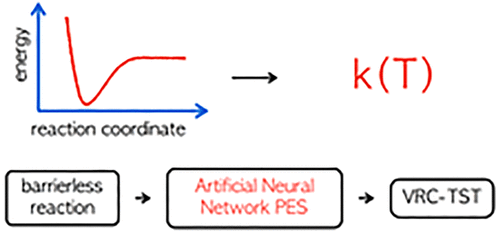当前位置:
X-MOL 学术
›
J. Phys. Chem. A
›
论文详情
Our official English website, www.x-mol.net, welcomes your
feedback! (Note: you will need to create a separate account there.)
Accelerating Variational Transition State Theory via Artificial Neural Networks.
The Journal of Physical Chemistry A ( IF 2.7 ) Pub Date : 2020-01-23 , DOI: 10.1021/acs.jpca.9b11507 Xi Chen 1 , C Franklin Goldsmith 2
The Journal of Physical Chemistry A ( IF 2.7 ) Pub Date : 2020-01-23 , DOI: 10.1021/acs.jpca.9b11507 Xi Chen 1 , C Franklin Goldsmith 2
Affiliation

|
An application of atomistic machine learning for variational transition state theory is presented. The rate constants for various radical-radical reactions are computed using variable reaction coordinate transition state theory. In order to simplify the calculation process, artificial neural networks are trained on a structured grid of potential energy data. The resulting surrogate potential energy surface is used in classical phase space representations to describe the interaction between two radical species in the gas phase. When the artificial neural network is trained to potential energy alone, the number of explicit electronic structure energy calculations required to compute a rate constant decreases by at least a factor of 4. When forces are included in the training data, the reduction is more dramatic-at least an order of magnitude.
中文翻译:

通过人工神经网络加速变分过渡态理论。
提出了原子机器学习在变分过渡态理论中的应用。使用可变反应坐标过渡态理论,计算了各种自由基自由基反应的速率常数。为了简化计算过程,在势能数据的结构化网格上训练了人工神经网络。生成的替代势能面用于经典相空间表示中,以描述气相中两个自由基之间的相互作用。当仅将人工神经网络训练为势能时,计算速率常数所需的显式电子结构能量计算的数量至少会减少4倍。当训练数据中包括力时,这种减少会更加剧烈-至少一个数量级
更新日期:2020-01-23
中文翻译:

通过人工神经网络加速变分过渡态理论。
提出了原子机器学习在变分过渡态理论中的应用。使用可变反应坐标过渡态理论,计算了各种自由基自由基反应的速率常数。为了简化计算过程,在势能数据的结构化网格上训练了人工神经网络。生成的替代势能面用于经典相空间表示中,以描述气相中两个自由基之间的相互作用。当仅将人工神经网络训练为势能时,计算速率常数所需的显式电子结构能量计算的数量至少会减少4倍。当训练数据中包括力时,这种减少会更加剧烈-至少一个数量级











































 京公网安备 11010802027423号
京公网安备 11010802027423号